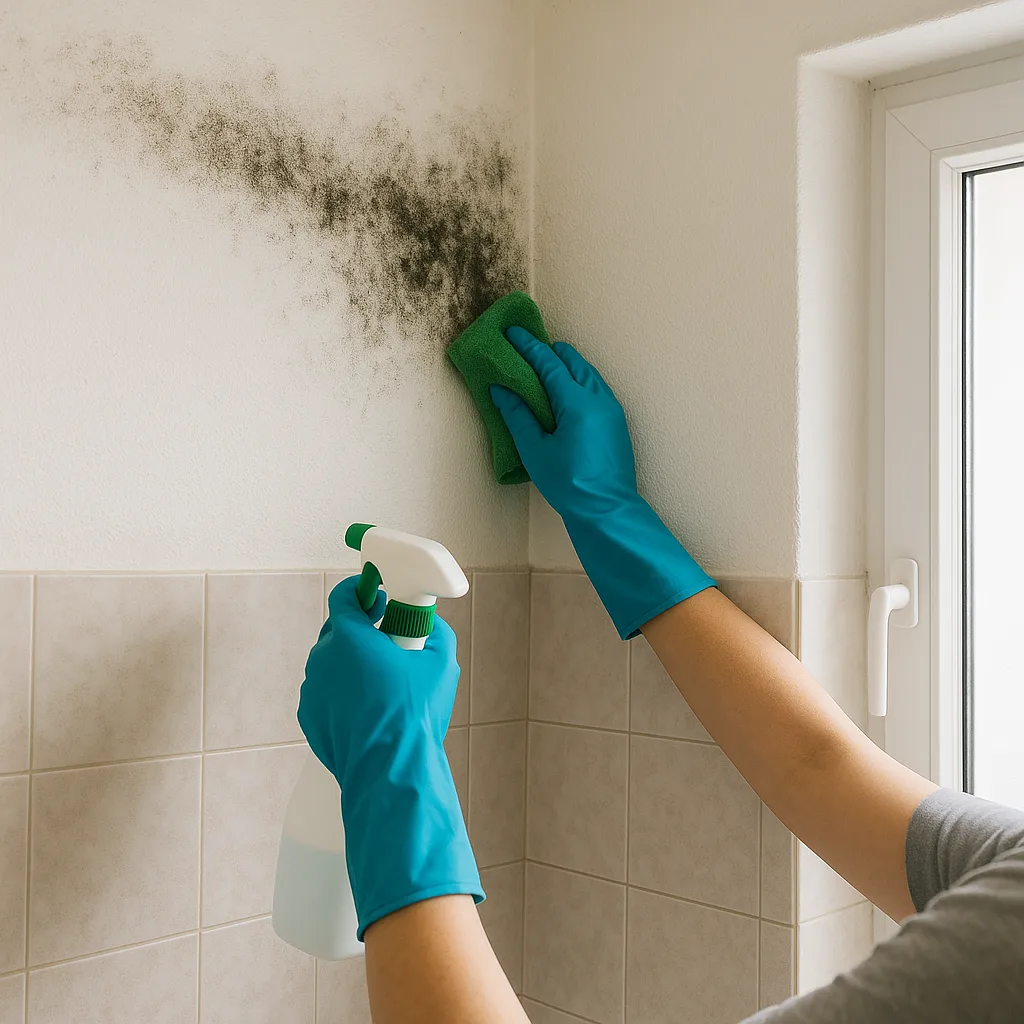🧽 How to Prevent & Remove Mould and Mildew in Melbourne Homes
Mould and mildew thrive in Melbourne’s changing climate. Learn why it appears, how to remove it safely, and proven strategies to keep it from coming back.

If you’ve ever caught that musty smell or noticed dark patches on ceilings and walls, you’re not alone. Melbourne’s humidity, cool winters, and shaded spaces create perfect conditions for mould and mildew.
Beyond appearances, mould affects health, structures, and peace of mind. This guide explains why mould appears, how to remove it safely, and how to stop it from returning.
🌦 Why Mould is So Common in Melbourne Homes
Melbourne’s unpredictable climate creates frequent condensation. Combined with older housing, smaller wet areas, and poor ventilation, it’s a recipe for mould.
- • Bathrooms: ceiling corners, grout, behind toilets
- • Bedrooms: wardrobes, windowsills, cold external walls
- • Kitchens: behind fridges, sinks, rangehood areas
- • Laundries/basements: moisture from washers and dryers
- • Inside wardrobes: overly packed clothing restricts airflow
🚨 Why You Should Never Ignore Mould
Airborne spores can trigger coughing, congestion, headaches, skin irritation, and asthma flare-ups. Children, older adults, and immunocompromised people are more vulnerable.
Under Victorian tenancy laws, landlords must resolve mould caused by leaks or structural issues, while tenants should ventilate and clean visible mould.
🧪 The Science of Mould & Mildew
Mould and mildew are fungi that thrive in moist, dark, still air. Spores are everywhere, activating when humidity stays above 60% and surfaces stay damp. Mildew is often superficial; mould can root deeper and stain.
🧰 Step-by-Step: How to Remove Mould Safely
1️⃣ Protect Yourself First
- • Wear rubber gloves
- • Use an N95 or P2 mask
- • Safety goggles
- • Ventilate: open windows and avoid dry-scrubbing
2️⃣ Choose the Right Cleaning Solution
Bleach can fade stains but often misses spores on porous surfaces. Try these options:
- • White vinegar (undiluted): Spray, leave 60 minutes, then wipe.
- • Baking soda: 1 tsp per cup of water for gentle scrubbing and deodorising.
- • Hydrogen peroxide (3%): For tiles and hard surfaces; helps with stains.
- • Eco-friendly mould sprays: Choose biodegradable, non-toxic formulas.
⚠️ Never mix chemicals (especially vinegar and bleach).
3️⃣ The Cleaning Process
- Spray your cleaner generously on affected areas.
- Wait 10–15 minutes to break down spores.
- Wipe with a microfibre cloth or soft brush.
- Rinse with warm water and wipe dry.
- Dispose of used cloths in a sealed bag.
Use an old toothbrush for grout and go light on moisture for painted walls.
4️⃣ Dry and Disinfect the Space
- • Use fans, heaters, or dehumidifiers
- • Open windows to flush out humidity
- • Moisture absorbers in wardrobes and bathrooms
🏠 How to Stop Mould from Coming Back
🌬 Improve Ventilation
- • Open windows daily (10 minutes helps)
- • Use exhaust fans for cooking and showers
- • Keep internal doors open when possible
- • Consider vent grills in problem areas
🚿 Manage Bathroom Humidity
- • Wipe shower screens and tiles after use
- • Use a squeegee to remove excess water
- • Leave bathroom door ajar post-shower
- • Clean dust from exhaust fans regularly
🧦 Don’t Dry Clothes Indoors
A full load releases over 2 litres of moisture. If you must, open windows or use a dehumidifier.
🌡 Monitor Indoor Humidity
Use a hygrometer and aim for 40–55%. Above 60% mould thrives; below 35% air can be too dry.
🎨 Use Anti-Mould Paint
Repaint problem areas with mould-resistant paint or additive, especially in wet areas.
🌿 Go Green
Air-purifying plants like peace lilies and snake plants can help reduce moisture and toxins.
👃 Dealing with Mould Smell
- • Leave bowls of white vinegar or baking soda overnight
- • Sprinkle bicarbonate soda on carpets before vacuuming
- • Use activated charcoal bags in small rooms or wardrobes
🧾 What to Do If You’re Renting
- Report it immediately to your property manager in writing
- Take dated photos to document the issue
- Keep notes of appearance dates and repairs
Landlords handle leaks/design faults; tenants must ventilate and clean visible mould.
🧹 When to Call the Professionals
- • Area over 1 m²
- • Patches keep returning after cleaning
- • Persistent musty odour without visible mould
- • Signs behind walls or under flooring
Our team uses industrial dehumidifiers, non-toxic treatments, and air purification to eliminate mould at its source—and identify causes so it doesn’t return.
💚 Eco-Friendly Mould Removal Tips
- • Vinegar + Tea Tree Oil: 1 cup vinegar with 10 drops tea tree oil
- • Baking Soda + Lemon Juice: gentle scrub with fresh scent
- • Hydrogen Peroxide + Water (50/50): powerful stain removal on tiles
Always test small areas first and keep spaces ventilated while cleaning.
🏡 Final Thoughts
With routine airflow, dry surfaces, and proactive cleaning, mould is manageable—even in Melbourne’s moody weather. And if it’s too much, we’re here to help.
At Clean Fridays, we specialise in mould removal, deep cleaning, and long-term prevention for Melbourne homes. We’ll inspect, clean, and restore your space so you can breathe easier.
✨ Ready for a mould-free home?
Book a professional clean today and keep your Fridays clean, calm, and carefree.
